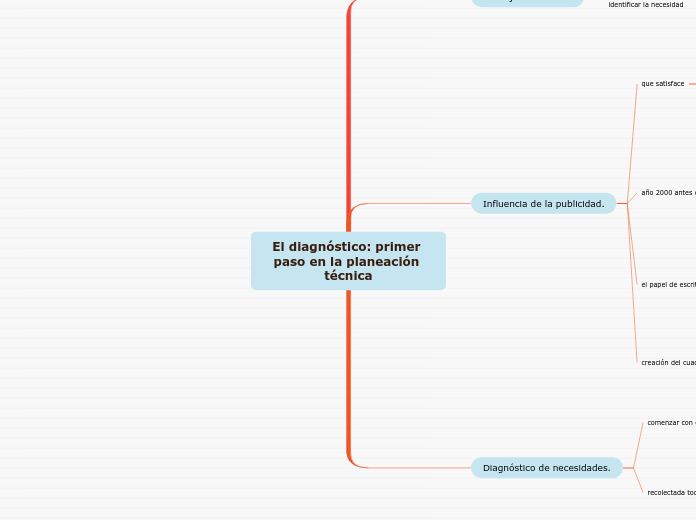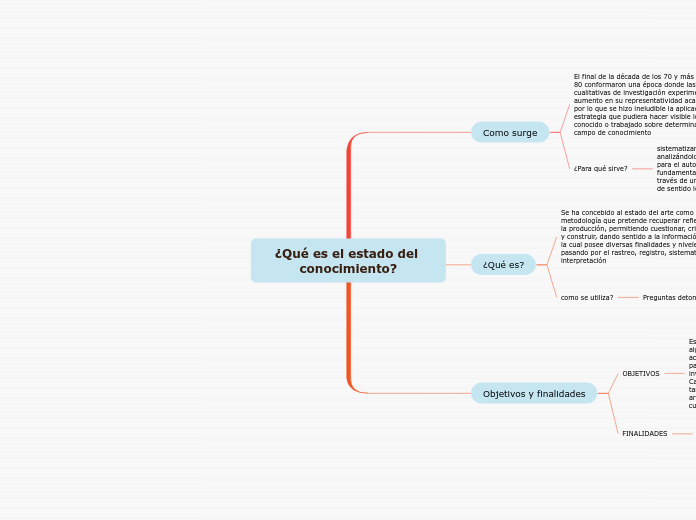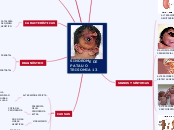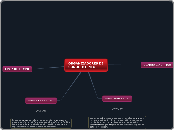El diagnóstico: primer paso en la planeación técnica
To name your story, you have to think about the overall message and what you want your audience to understand from the story. Also, make it relevant and easy to remember.
Diagnóstico de necesidades.
The ending of a story is essential. We all know that if the ending is weak, what happened before loses its importance. So make it unpredictable, but fair. A resolved ending answers all the questions and ties up any loose threads from the plot.
recolectada toda la información
This is the closure section of the story.
See examples of possible outcomes below:
- all problems have been solved
- it's clear how each one of your characters ends up
- your main character is transformed by the challenge
Finalmente, con base en lo que se haya encontrado, se pueden definir los problemas técnicos que se derivan de ellas y buscar alternativas de solución, optar por una y desarrollarla.
es necesario organizarla, de modo que se puedan identificar fácilmente las necesidades que se encontraron y, a partir de eso, poder compartir los hallazgos para luego satisfacer esa necesidad con un producto o servicio.
Try answering these questions to come up with a closure:
- Have all the problems been solved?
- Is there a clear picture of what happens with each character in the story?
- Has the challenge transformed your main character?
- How do the characters feel in the end?
comenzar con el diagnóstico
This is the moment when the main character surpasses the last obstacle and finally faces their greatest challenge.
The climax usually follows one of these patterns:
- realization
- resolution
- choice
Type in your answer.
pon mucha atención en las necesidades que observar en tu entorno, por ejemplo, en tu casa. A partir de lo que observas, empiezas a generar algunas suposiciones sobre necesidades de tu familia que no están satisfechas e incluso acerca de las causas y consecuencias que esto tiene para tu vida cotidiana.
es necesario recolectar información que provenga de quienes pueden tener esa necesidad. Entonces, es cuando se puede observar, ya de manera más sistemática, para saber si la necesidad que se propone no está satisfecha.
Influencia de la publicidad.
The middle of the story is where you add layers of complications that will lead to the end. Reveal more about the character's journey. Did their personality go through changes? How did they overcome the challenges? And as you build up the story’s central conflict, make it more personal to that character. Also, from the middle act, you have to lead into the final act.
creación del cuaderno
año 1920 el australiano J. A. Birchall creó el cuaderno. Aunque no era como se conoce ahora, pues sólo eran varias hojas unidas por un pedazo de cartulina. En este caso, ya no sólo se tenía un objeto para plasmar las ideas, sino que se podía hacer de manera ordenada.
el papel de escritura
There wouldn't be any tension and excitement in your story if there weren't any obstacles in your character's way.
Los chinos no se quedaron atrás y crearon algo muy importante para escribir: el papel. Utilizaban la tinta china y las plumas de ave para plasmar sus ideas, y a pesar de ser tan antiguo el papel, fue hasta que se creó la imprenta, cuando se transformó por completo la forma de escribir
los griegos empezaron a utilizar pieles de algunos animales para escribir. Sin embargo, en Pérgamo, hoy Turquía, se desarrolló esta técnica con mayor éxito, por eso a ese material se le conoce como Pergamino.
A story is nothing more than a character overcoming a series of difficulties to reach the desired goal. Obstacles usually create suspense and conflict. In overcoming obstacles, there is growth: weak becomes strong; hatred turns into love; sadness into happiness; wrong into right; lies into truth; or evil becomes good.
See a few examples below:
- stopping a meteor
- finding a killer
- finding love
año 2000 antes de nuestra era
Your character(s) need(s) motivation in order to solve the challenge(s).
se utilizaban otros materiales para la escritura. Eran fibras de papiro las que se usaban como papel y la resina con grasa animal y ceniza era utilizada como tinta por los griegos, romanos y egipcios.
Secondary characters might also have motives that lead them to cross paths with the main character or which might trigger them to help the main character.
los habitantes en Mesopotamia elaboraron tablillas de arcilla en las que grabaron símbolos con punzones que representaban ideas, situaciones y registros para el comercio.
Why does your character need to confront this challenge? What does he/she expect to accomplish by solving it?
See a few examples:
- will marry in 3 days
- can fix the mistakes of the past
que satisface
Each story has a main character and that character usually needs to solve a problem or challenge. The character's challenge is the one that creates tension throughout the story.
ej:
Type in any other challenges which other characters in the story need to face.
Anteriormente no se usaban letras, sino imágenes pictográficas estilizadas de animales pintadas en piedras, como ciervos, toros y caballos, así como contextos o situaciones representadas con pigmentos rojos, amarillos, ocres y negros, los cuales eran de origen vegetal como el carbón, arcilla y óxido de fierro, entre otros.
La necesidad que satisface un cuaderno depende del ámbito en el que se utilice
de manera general, se podría decir que es para comunicarse por escrito, plasmar ideas e incluso expresarlas mejor y recordarlas.
al estar satisfechas las necesidades básicas, surgen otras o se modifican al estar influenciadas por la imitación o la publicidad.
In most stories, there are 3 challenges. The number 3 is a mystical number symbolizing completeness. Try to come up with interesting challenges with which your character needs to struggle.
See a few examples below:
- turns into a werewolf at night
- is sent back in time
Los anuncios en televisión, internet, revistas o carteles incitan a comprar, aunque no necesites hacerlo.
los objetos técnicos
In the beginning of the story (or the exposition), you will need to introduce the setting and characters. You might also want to introduce the main conflict. This part of the story is important because it gives the reader necessary background information and maybe even a first insight into a character’s personality.
responden a una necesidad. Por eso, antes de generarlos se tiene que hacer un diagnóstico para identificar la necesidad
Characters are essential to a good story. Usually, the protagonist(s) is/are the most affected by the plot. Introduce a character by focusing on their actions, interests, and occupation, as the physical appearance doesn't make a difference in most cases.
Las necesidades se refieren a la falta o privación de algo y se dividen en básicas y secundarias.
Type in the name of your character.










